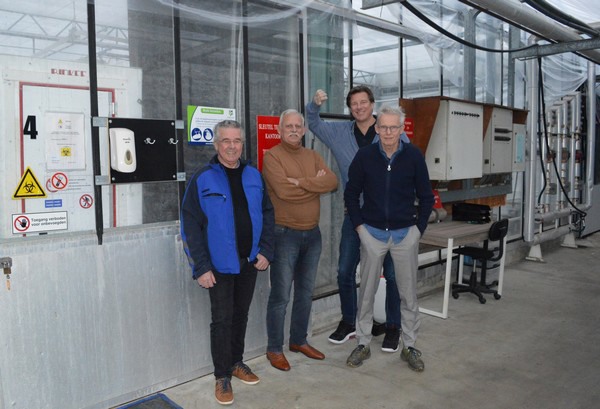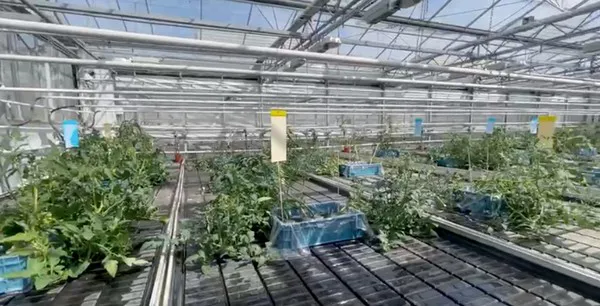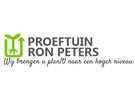On a Tuesday afternoon in early January, four men quickly come to an agreement over a cup of coffee. Clean water is crucial in order to eradicate the Tomato brown rugose fruit virus (ToBRFV). "As long as water from basins or silos often enters the greenhouse untreated, we will be fighting a losing battle", they concluded.
An existing technique to combat ToBRFV in water based on ultrasound, and which has been further improved in recent years, addresses this issue. Last year, research at the Ron Peters Experimental Garden confirmed its effectiveness. This year, Ultramins and Luyckx Ultrasound, the exclusive seller and producer of the technique, want to demonstrate that the technique can also kill off the virus in water within one hour. A new test will be carried out for this at the Klazienaveen experimental garden.

Kees Luijkx, Rien Rodenburg, Robert de Hoo and Ron Peters in front of the greenhouse at Proeftuin Ron Peters where research into ToBRFV control is being carried out.
Complex problem
At the trial garden, researcher/growers Ron Peters has gained ample experience in recent years with the new tomato virus, a virus from the group of tobamoviruses that is highly persistent. Earlier, he had already made a name for himself with research and a protocol for controlling the cucumber green mottle mosaic virus (CGMMV). To be allowed to work with ToBRFV, he had his greenhouse complex specially adapted, so that he is certified to grow with the virus. Ron: "As soon as the virus appeared, growers started calling. The more calls I usually get, the bigger the problem is. That is certainly the case with ToBRFV. It is a very complex problem."
As he has the certification to grow with the ToBRFV, companies with virus control products that believe they can fight the virus also know how to find him. Laughing, and with a wink: "The current European Q-status is good for me. They are queuing up." But then more serious: "It is important that steps are taken quickly in research. That is what is we will do. Just as the cucumber green mottle mosaic virus is now well under control and growers know how to deal with it, the same will be true of ToBRFV in a few years' time. However, even better protocols are needed, as well as control techniques, to be able to continue without Q-status."
Astonishment
Both protocols and techniques are discussed at the table in Klazienaveen. Robert de Hoo and Kees Luijkx brought one of these techniques to the experimental garden last year, after a tomato grower with an algae problem in his basin had pointed this out to them. It concerns USAF ultrasonic transmitters, produced by Luykx Ultrasound and sold exclusively by Ultramins since last year.

USAF ultrasonic transmitters
Danger of dirty watering
As soon as ToBRFV surfaced, Kees was on the case. He repeatedly referred to his technique, has has had good anti-virus properties attributed to it since the 1950s. Still, according to both Kees and Robert, horticulture is not yet sufficiently aware of the danger of dirty watering. Robert expressed his surprise last year at the large percentage of growers who still pump untreated water into their greenhouse from basins or silos.
This is nothing new for Rien. He has gained extensive experience in horticulture at home and abroad and was involved as a supervisor in the research with the USAF transmitters at Proeftuin Ron Peters. He dares to state that 90 per cent of virus infections originate from water. All three men nod. Regardless of whether the percentage is correct, they agree that dirty water is a major danger, and still is. Kees: "In my opinion, growers still do not know exactly where the dangers are. Ron: "Hands and water are the most dangerous when it comes horticultural viruses."
High dose
In the study commissioned by Luijkx Ultrasound and Ultramins last year, the focus was on water. The tomato plants in the study, about four weeks out and ungrafted, were thoroughly tested, as were the USAF transmitters. A total of 15 kg of ToBRFV-infected tomatoes and leaves were ground into 'soup' and added to 100 litres of water. This water was given to the plants from two watering cans. These were both treated for 24 hours with ultrasonic, supplemented with regular non-stabilised hydrogen peroxide in two doses. Kees: "The ultrasonic shock wave breaks the membranes of the virus in one blow. After that, a small amount of hydrogen peroxide ensures that what is broken down remains broken."
Unlike in many virus research projects, it was decided to administer the virus to the plants via water, and moreover at a very high dose. Ron: "This means we now know that the transmitters work well, precisely because such high doses of ToBRFV do not occur in practice." After contamination, the plants were tested for the virus. A test on living plants was chosen, because a PCR test of the virus water does not give a result on living or dead virus material. "Living or dead can only be determined by contamination of the plants. In this case, via uptake through the roots."

Trial design in the study completed last year
Dead or alive?
Even from extremely polluted water, Ct-values in the plants after leaf sampling were shown to significantly reduce, if not completely exclude, the possibility of re-infection, Ron indicated earlier. Good news for Kees and Robert, but they still want to take extra steps. To this end, a new study will be started this year. Robert explains why. "Actually, I would like to know how much ToBRFV in water is currently being researched elsewhere in the testing of virus control techniques. We were deliberately very high in the ToBRFV dose, but how is it elsewhere? I can't seem to get answers, which is disappointing. It makes me wonder sometimes whether everyone is really looking for a solution to this virus problem."
Kees agrees, but with the nuance that he is sure growers are indeed looking for that solution. With the knowledge that he and Robert have of the USAF transmitters, they think that treating water with ultrasound for a much shorter period of time is enough to render the virus harmless. New research should reveal this this year. Another step that is being considered is to invest in measuring technology that makes it possible to quickly demonstrate that the virus has been killed off. Kees: "Such techniques already exist, but I doubt whether they are being used very much." He points to electron microscopes and flow cytometry. The latter technique is known to breeding companies, but the equipment alone is not enough to measure ToBRFV. Software needs to be written for this purpose, Kees says, and as far as he knows this software does not yet exist.
Speed and dormancy
This speed is important because the virus does not show itself immediately after infection. Ron: "Tomato plants in particular are hardy, which means that the symptoms only really become visible when the plant is stressed. This is often from April onwards, when there is a lot of radiation and a fully bearing crop. That is when the virus often emerges, but that does not mean that it isn't already present." Rien adds; "With plants in summer, you can therefore see the virus after just seven days. At other times of the year it can take longer."
Before the men started thinking about this year's trial design, one more point of interest was raised. That is the advance of (intermediate) resistant varieties. Rien points out the dangers. "An intermediate resistant variety will no longer show any symptoms when infected with a virus, but that does not mean that the virus cannot still be present in the greenhouse. Moreover, it has been proven that intermediate resistances lose their power at temperatures higher than 36 degrees Celsius. This is now also a regular occurrence in the Netherlands in the summer." In other words, the horticultural sector is not immune to the virus. Reason enough for Robert to mention the USAF transmitter again. "With it, growers can treat their water properly to prevent virus contamination and spread."
For more information:
Ron Peters 
Proeftuin Ron Peters
Gantel 12
7891XA Klazienaveen
+31 (0)6 2505 2941
info@ronpeters.nl
www.ronpeters.nl
Kees Luijkx 
Luykx Ultrasound B.V.
Dorsvlegel 10
1648HX De Goorn
+31(0)6 5351 2961
kees@ultrasoundinfo.nl
www.usaf.nl
Robert de Hoo 
Ultramins B.V.
Jelle Zijlstraweg 45
1689 ZX Zwaag
+31 (0)6 2053 6536
+31(0) 85 023 10 97
info@ultramins.com
